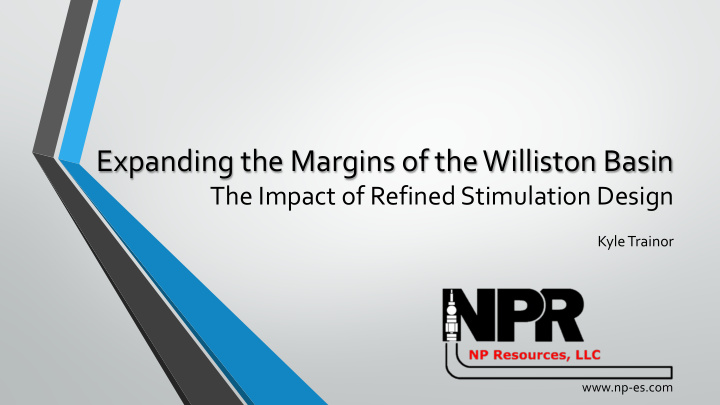



Expanding the Margins of the Williston Basin The Impact of Refined Stimulation Design Kyle Trainor www.np-es.com
Overview • Project Overview • Locator Map • Economic Opportunity • Continuous Improvement Cycle • Design Process • Data Evaluation and Integration • Oil Potential Variation • Perforating and Proppant Diversion • Results and Conclusions
Overview Map –Williston Basin Elkhorn project, 5 wells D&C 2017+ Engineered completions (mass and placement) • 4.3 – 7.4 MM lbs proppant • 33-35 stage slickwater completions • Limited entry perforating •
Economic Opportunity • Project area was initially delineated by legacy completions: • Vertical wells, vintage unstimulated horizontals and early x-link completions. • Contemporary completions in offset analog field suggested meaningful ROI upside if completions and associated production could be maximized. • Pilot hole logs and regional geology suggested an opportunity for refinement through engineered completions.
Continuous Improvement Cycle Refine understanding of reservoir and geologic properties and identify any potential interaction between parent and child wells Execution and ongoing process Define fracturing improvement through characteristics field validation Measure rock Integrated completion mechanics and pore design fluid variations across laterals
Data Evaluation – Elkhorn Field • Completion evaluation suggested poor lateral efficiency from legacy completions. • The water cut from legacy completions suggested stimulations were communicating with adjacent layers containing higher water saturations. • Very high oil cut (90% – 100%) in unstimulated wells • Low oil cut from x-link completions (30 – 40%) • The variation in production responses appeared to be more closely related to variations in stimulation and execution than reservoir quality.
Integrated Design Process • Completion design must be optimized to accommodate reservoir variability along the lateral. • Stage length and number of clusters were customized based on variations in mechanical properties. • Segments of high or low stress are grouped into stages. • Changes in average stress in the lateral dictate required perf friction for limited entry to work. • Increased investment in larger frac treatments was justified in stages with thicker pay or higher oil saturations • Smaller stages were used in stages displaying reduced potential to maximize ROI
Optimization Example - Perforating 500 ft stage – 12 to 14 clusters 180-220 ft stages 6-8 clusters • Stages can be expanded and contracted to contour rock stress, minimize wireline runs while maximizing cluster efficiency
Lateral Variability-Feet of Saturation Feet of Oil Saturation in the Lateral – 5 Elkhorn Wells • Not all wells need the same mass of proppant and volume of fluid, fine tuning the right job mass by stage is key.
Optimization Example – Job Mass 500 ft stage – 12 to 14 clusters 180-220 ft stages 6-8 clusters Targeting pay with proppant maximizes ROI A Given Mass of Proppant
Perforating • Average cluster efficiencies of >90% per stage can be achieved by: • Adapted extreme limited entry as piloted by Liberty Resources • Grouping stages by similar stress • Matching perf friction to overcome rock stress variations by stage • Oriented perforating • Equal exit hole diameter charges • Perforating efficiencies are gauged by: • Initial and final step rate tests • Chemical tracers SPE 189880-MS
Proppant Diversion • High efficiency limited entry can be combined with proppant slugs to produce similar trends in observed net pressure to other diverting agents. • Post job step rate test confirm a reduction in clusters taking fluid through the course of the stage. Net pressure increases with higher proppant concentration entering perfs on 2 nd ramps and 4 th ramps Post job step rate test Initial step rate test
Results – initial program • Project area wells show 4x uplift from legacy wells. • Meaningful upside ROI was realized with an engineered completion approach turning a “marginal” field into a development project with robust economics. • Still in relatively early stages of program (5 wells) with more process improvements planned.
Conclusions • Cluster efficiencies of >90% were achieved with limited entry. • Rock mechanics measured in the lateral helped drive stage placement and limited entry design. • The proppant mass and fluid volume were tied to the fluid saturations in each stage. • The engineered completion improved the effective stimulation with an increase of ~four times the legacy well baseline production. Measurements of rock stress and pore fluid volume in the lateral were an important part of this design approach. • Questions?
Recommend
More recommend